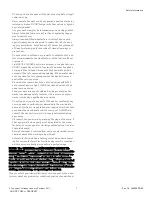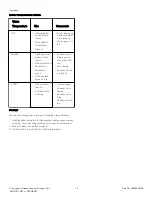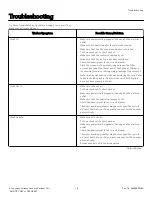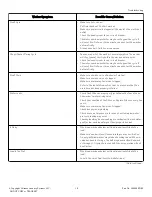
Maintenance
Cold Weather Care
If the unit is delivered on a cold day (below freezing), or is stored in
an unheated room or area during the cold months, do not attempt
to operate the washer until it has had a chance to warm up. Water
from the previous cycle may remain.
Care of Your Washer
Use only a damp or sudsy cloth for cleaning the control panel. Some
cleaning products may harm the finish on the control panel or dam-
age the interior. DO NOT use products that contain alcohol on the
control panel. Wipe the panel dry after cleaning.
Wipe the washer cabinet as needed. If detergent, bleach or other
washing products are spilled on the cabinet, wipe immediately.
Some products will cause permanent damage if spilled on the cabi-
net.
Do not use scouring pads or abrasive cleansers on control panel or
cabinet.
The washtub will need no particular care though it may need rinsing
or wiping after some unusual loads have been washed. This also may
be necessary if too little detergent has been used.
Leave the lid open to allow the inside of the washer to dry out after
use. This helps prevent musty odors from developing.
The agitator should not be removed except for service. The washtub
is designed to be self cleaning.
Replacing Hoses
Hoses and other rubber parts deteriorate after extended use. Ho-
ses may develop cracks, blisters or material wear from the temper-
ature and constant high pressure they are subjected to.
All hoses should be checked on a monthly basis for any visible signs
of deterioration. Any hose showing the signs of deterioration listed
above should be replaced immediately. All hoses should be replaced
every five years.
Filter Screens
Check the filter screens in the fill hoses for debris or damage every
six months. Clean or replace them if necessary.
If the washer is filling with water slower than normal, check the fil-
ter screens. Clean or replace them if necessary.
Order filter screen Part No. 803615 from the nearest authorized
parts distributor.
Vacations and Extended Non-Use
IMPORTANT: To avoid possible property damage due to
flooding, turn off the water supply to the washer whenev-
er there will be an extended period of non-use.
Preventative Maintenance
Follow these guidelines to ensure the washer operates properly. Call
for service if you observe any of the following: water of any amount
on the floor, an increase in operating noise or water remaining in the
wash basket after a cycle.
Frequency
Maintenance Procedure
Monthly
1. Check all hoses and the
drain for leaks.
2. Check the lid switch for
proper operation.
3. Check to make sure the
washer is level.
4. Clean upper 2-3 inches of
wash tub. Fill washer with
warm water at highest set-
ting. Use an all-purpose
cleaner or a steel wool soap
pad.
Every six months
1. Clean the filter screens in
the fill hoses.
Every five years
1. Have a qualified service
technician conduct general
preventative maintenance
on the washer to ensure it
operates properly.
2. Replace the fill hoses.
Reinstallation of Shipping Materials
You must install the shipping brace and shipping plug any time the
washer is moved.
Shipping Brace
The shipping brace in the lid opening should be saved and reinstalled
whenever the washer is moved. To reinstall the brace, open the
washer lid and place the brace over the washer agitator, placing the
back of the brace into the lid opening first.
Maintenance
©
Copyright, Alliance Laundry Systems LLC -
DO NOT COPY or TRANSMIT
16
Part No. 203963ENR2
Summary of Contents for Speed Queen LWN311SP101NW22
Page 2: ......






































